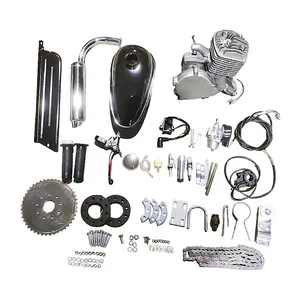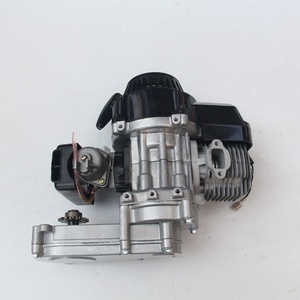(966 products available)



































































































































































































There are several types of 2-stroke pocket bike engines. Here is a breakdown of the different types:
Standard 2-stroke engines
Standard 2-stroke engines rely on the pressure difference created by the piston moving up and down in the cylinder to transfer air. These engines are simple and inexpensive, making them ideal for standard bikes.
Supercharged 2-stroke engines
Supercharged 2-stroke engines have a mechanical or electrical supercharger that increases air pressure in the cylinders. This allows for more air and fuel to enter the combustion chamber, resulting in more power output. Supercharged engines are complex and expensive, making them ideal for high-performance pocket bikes.
Twin-cylinder 2-stroke engines
Instead of one, these engines have two cylinders working together to create power. The two cylinders fire alternately, providing smooth and consistent power delivery. Twin-cylinder engines are more complex and expensive than single-cylinder engines, making them ideal for larger and more powerful pocket bikes.
Counterbalanced 2-stroke engines
Counterbalanced 2-stroke engines have a counterbalance shaft or weight that reduces engine vibration. This provides a smoother ride and less wear and tear on the pocket bike components. Counterbalanced engines are typically found on higher-end or racing pocket bikes.
Electric start 2-stroke engines
These engines are pocket bikes that have an electric starting system, such as a battery and starter motor. This eliminates the need for a pull-cord or kick-start, making it easier to start the engine. Electric start 2-stroke engines are generally found on higher-end or adult-oriented pocket bikes.
All these different types of 2-stroke pocket bike engines are suitable for different purposes and preferences. Buyers can find an engine that fits their pocket bike's desired performance level and characteristics. Most of these engines are popular due to their lightweight and powerful nature, making them suitable for various applications, including different types of pocket bikes.
Oil and Gas Mixture
Regularly check and refill the oil and gas mixture as needed. The recommended mixture ratio is typically 25:1 or 50:1, depending on the engine's specifications. Use high-quality 2-stroke oil and fresh gasoline to ensure optimal engine performance and lubrication.
Air Filter Maintenance
The air filter should be inspected regularly and cleaned or replaced as necessary. A clean air filter ensures proper airflow to the engine, improving fuel efficiency and overall performance. Dust and debris accumulation can clog the air filter, restricting airflow and affecting engine performance.
Spark Plug Inspection
Inspect the spark plug for signs of wear or carbon buildup. Clean the spark plug using a wire brush or replace it if necessary. The spark plug plays a crucial role in igniting the fuel-air mixture in the engine's combustion chamber, and its proper functioning is essential for reliable engine performance.
Fuel System Cleanup
Over time, fuel residues and deposits can accumulate, affecting engine performance. Perform a fuel system cleanup using appropriate cleaners to remove these deposits. This will help maintain optimal fuel flow and combustion efficiency. Follow the manufacturer's guidelines for fuel system cleaning procedures and recommended cleaning products.
Exhaust System Inspection
Check the exhaust system for any leaks, cracks, or damage. Ensure that all connections are secure to prevent exhaust leaks, which can impact engine performance and emissions. A properly functioning exhaust system allows for efficient exhaust gas flow, reducing backpressure and maximizing engine power.
Cooling System Check
The engine's cooling system should be inspected regularly to prevent overheating. Ensure that the coolant level is adequate, and the cooling fins and radiator (if applicable) are clean and free from debris. Overheating can cause severe engine damage and reduce its lifespan.
Regular Engine Lubrication
Regularly lubricate the engine components as per the manufacturer's recommendations. Use high-quality lubricants to ensure smooth operation and reduce friction between moving parts. Proper lubrication minimizes wear and tear on the engine, improving its durability and reliability.
Here are some factors to consider when choosing a 2-stroke pocket bike engine:
Engine Size and Power
Smaller engines power the bike less and offer slower speeds. Buyers should choose engines depending on the riding experience they need to offer. For a thrilling experience, go for engines with high displacement and power output.
Weight and Size
The pocket bike engine chosen should be proportional to the size of the bike. A well-fitted engine allows for even weight distribution and optimizes the bike's performance. When the engine is well fitted, it also improves the bike's handling capabilities.
Cooling System
Some 2-stroke pocket bike engines have air cooling systems, while others have water cooling systems. Water cooling systems offer more stable and reliable engine performance. Buyers should choose engines with cooling systems to match the bike's design.
Torque Characteristics
Buyers should choose engines that produce torque suitable for their riding style. For example, if the bike is designed for racing, buyers should choose engines with higher torque output. Such engines allow quick acceleration and high-speed performance.
Fuel Efficiency
Different 2-stroke pocket bike engines have different fuel efficiencies. Buyers should research and choose engines with better fuel efficiency. Such engines will reduce the cost of fuel during operation. Also, when the bike is fueled efficiently, it produces fewer emissions, making it environmentally friendly.
Ease of Maintenance
Buyers should consider the maintenance requirements of the 2-stroke pocket bike engine they choose. Some engines are designed with features that make it easy to maintain and repair. Buyers should choose engines with easy-to-maintain features for a convenient experience.
Replacing a 2-stroke engine pocket bike can be a straightforward process. Follow the steps below to ensure that the process goes smoothly.
Here is a detailed explanation of each step:
Carry out all the necessary preparations: Before starting the replacement process, make sure to have everything ready. This includes having the right tools for the job and the new 2-stroke pocket bike engine ready for installation. Additionally, make sure the pocket bike is turned off and has no fuel in the tank to prevent any fires or explosions.
Drain the fluids from the old engine: Once the preparations are done, the next step is to drain all the fluids from the old engine. This includes oil and gasoline. Collect the drained fluids in a container and dispose of them according to local regulations.
Remove the old engine: After draining the fluids, the next step is to remove the old engine. This involves using the right tools to unscrew the bolts that hold the engine in place and disconnecting any other components that are connected to the engine.
Install the new engine: Installing the new engine is simply the reverse of removing it. Place the new engine in the pocket bike and connect it to the other components using the right tools.
Refill the fluids: Once the new engine is installed, refill it with the fluids that were drained in the second step. This includes oil and gasoline. Make sure to use the recommended type and amount of fluids for the new engine.
Check for leaks and test the engine: Before riding the pocket bike, check for any leaks around the engine and make sure there are no visible leaks. Once sure there are no leaks, start the engine and test it to ensure it is running smoothly.
Q1: Can any bike engine be converted to a 2-stroke?
A1: In theory, it's possible to convert a 4-stroke engine to a 2-stroke, but it's complex and often impractical. The firing and combustion processes would need to be entirely reconfigured.
Q2: How long do 2-stroke pocket bike engines last?
A2: Pocket bike engines have a relatively short lifespan of about 2000 hours or less, which is lower than their 4-stroke counterparts. However, with proper maintenance, they can last longer.
Q3: Are 2-stroke engines suitable for beginners?
A3: Due to their high power delivery, 2-stroke engines can be challenging for beginners to handle. Many 2-stroke engines have a rapid power band that can make the bike feel jumpy.
Q4: Can 2-stroke engines be used for any type of biking?
A4: Yes, 2-stroke engines are versatile and can be used for various biking styles, including road, dirt, and motocross. However, pocket bikes can only be used on closed tracks or private properties.
Q5: Are 2-stroke engines more fuel-efficient than 4-stroke engines?
A5: Generally, 2-stroke engines are less fuel-efficient than 4-stroke engines. They tend to use more fuel due to their design and higher power output.